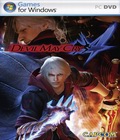Genre: Action
Publisher: Capcom
Developer: Capcom
Release Date: February 5, 2008
Devil May Cry is a fairly unique series in that, despite only being a few years old, it has a history as long and confusing as some of the longest-running video game franchises. Originally, Devil May Cry was going to be Resident Evil 4, back in the long-ago time before the eventual revisions gave us the current Resident Evil 4. However, as development went on, the character designs and the overall direction of the game diverged so greatly from the Resident Evil formula that it ended up becoming its own game, and Devil May Cry was born.
While Devil May Cry was met with incredibly positive reactions by gamers, its overall difficulty turned off a lot of players, and the sequel, Devil May Cry 2, tried to remedy this by lowering the difficulty, aging Dante a bit and introducing a new co-protagonist, the mysterious Lucia. Unfortunately, DMC2 was a lackluster, boring, uninspired sequel that was met with general disdain, even though reviewers generally gave it positive marks. The backlash against DMC2 was so strong that it was all but stripped from the series canon and became the butt of jokes in other Capcom titles, like Viewtiful Joe. In an attempt to revitalize the franchise, Capcom returned to Dante's origins in both story and gameplay with Devil May Cry 3, and once again, it was met with favorable reactions from hardcore gamers, although many casual players found that the steep difficulty rendered the title nearly unplayable. So here we are at Devil May Cry 4.
In many ways, Devil May Cry 4 represents another new start for the Devil May Cry franchise. The former protagonist, Dante, now shares the spotlight with a newcomer, Nero, a knight of the Holy Order of the Sword. With this comes a lot of revamps that make the title much friendlier to new gamers, while keeping the style and flair that Devil May Cry veterans are sure to love. For example, the game includes a built-in tutorial, a series of minor interface changes that make things much easier to pick up and learn, and a more gradual difficulty curve, so those gamers who were torn apart by Devil May Cry 3's unforgiving opening stages won't suffer the same problem here.
The biggest difference, however, is in the new main character, Nero, who is a mirror of Dante in many ways. He's cocky, arrogant and possesses incredible demonic powers. The two even look alike, although Nero is clad in blue instead of Dante's trademark red. Despite all of their similarities, Nero and Dante are very different beasts when they get onto the battlefield. Unlike Dante, Nero isn't the kind of guy who grabs any weapon he can get his hands on. For the most part, he sticks to his iconic weapons, the Red Queen and the Blue Rose, a matched set of sword and double-barreled pistol that make him a formidable force. The Blue Rose is a fairly simple weapon that fires slower than Dante's Ebony and Ivory, but packs a greater punch. The Red Queen is a single large blade that has a fuel-injection system; by cranking its motorcycle-esque hilt, Nero can "rev" the Red Queen to charge up its Exceed gauge, sort of a one-use super attack. When unleashed, the super attack comes out as an ultra-powerful flaming version of the regular attack. As Nero progresses, he can further build up his Exceed gauge, which allows him access to greater levels and more powerful attacks. Learning precisely when to rev the Red Queen is important, as every moment that Nero spends building up his power is one more moment that he's a sitting duck for enemy attacks.
Nero's most potent and deadly weapon by far is the Devil Bringer, a glowing demon arm that allows him to project a giant ethereal hand that he can use to interact with enemies and environments. For example, Nero can use the Grim Grip ability to grab onto glowing orbs that are scattered through the stages and swing from them Bionic Commando-style. However, their greatest use is in context-sensitive attacks. Any time Nero uses the Devil Bringer's Buster attack on a foe, he unleashes a special throw attack on the enemies. He pounds some into the ground, while he may swing others around like a giant pair of nunchucks, spear them with their own weapons or even turn them into makeshift weapons to use against other foes. The greatest use, however, comes in DMC4's giant boss battles. While bosses are regularly immune to the Bringer's effects, if Nero is careful and manages to either stun the foe or counter one of their attacks at the proper moment, he can unleash a hidden super move that does massive damage. While it's entirely possible to defeat DMC4's big baddies without using these moves, true Devil May Cry masters will want to discover these weak points to deliver the maximum beatdown to their demonic foes.
To further increase his awesome powers, Nero can transform into his unique Devil Trigger state. Unlike Dante, however, Nero's Devil Trigger doesn't cause a transformation but instead boosts the power of his ethereal Devil Bringer. It turns the spiritual hand into a second, superimposed ghostly figure, so Nero's every attack hits twice, allowing the hero to perform tremendous combos with incredible ease. The biggest advantage is that in the Devil Trigger state, Nero's Devil Bringer special attacks become even more powerful and gain new animations and abilities. A regular Devil Bringer throw, for example, may cause Nero to spear his unlucky foe before activating the spear's built-in rocket to send him flying, but in Devil Trigger mode, Nero holds onto the spear as it flies, allowing him a quick way to travel while building his combo.
While players spend most of the game as Nero, series veterans shouldn't fear. Devil May Cry 1-3 protagonist Dante is back and is just as good as ever. At certain points during the game, players get the chance to control the classic hero, who plays quite similarly to his Devil May Cry 3 incarnation. Armed with a shotgun and pistols, as well as his Rebellion sword, he's ready to kick butt and take names.
In Devil May Cry 3, Dante could choose one of four styles: Gunslinger, Royal Guard, Swordmaster and Trickster, each of which gave him a unique set of actions. Devil May Cry 4 introduces the Style Change ability, which lets players use the Xbox 360's d-pad to make Dante switch between styles on the fly. Now players can use the Trickster's ability to teleport to move quickly to an enemy, quickly switch over to Swordmaster to unleash a devastating combo and then finish off nearby enemies with a special Gunslinger move. It's a natural evolution of Dante's Devil May Cry 3 abilities, and it really helps keep the seasoned veteran's gameplay feeling fresh.
Of course, Devil May Cry 4 looks great. The franchise has, quite expectedly, made the transition to the next generation with flying colors. Between the fearsome enemies, wide-open environments and gigantic bosses, it's simply a visual treat, in keeping with the Devil May Cry franchise's sense of style and panache. For those wondering, the insane over-the-top cut scenes found in Devil May Cry 3 have returned, and most of them still blur the line between "awesome" and "goofy." You'll find plenty of crazy action in the cut scenes, and those who endured Devil May Cry 2's more "adult" (and utterly boring) Dante, don't worry: He may have gotten older, but he's certainly not much more mature.
Veteran voice actor Johnny Young Bosch, known for his roles such as Vash the Stampede in Trigun and Ichigo in Bleach, lends his voice to Nero, with excellent results. While Nero certainly is a smug fellow, Bosch manages to do a good job differentiating him from Reuben Langdon's Dante so that you don't feel like you're playing two different-sounding versions of the same character. Likewise, the rest of the game's voice acting is quite good, carrying the right blend of intentional cheesiness that meshes quite well with the insanely over-the-top visuals. The soundtrack is quite similar to Devil May Cry 3's, mixing pulse-pounding techno-rock music for the action sequences with quiet tunes for the lulls in the action; both types of music serve their purpose quite well.
Devil May Cry 4 is shaping up to be a fantastic addition to the franchise, while still retaining the exciting gameplay for which the series is known. Nero fits in quite well in the DMC universe, and his Devil Bringer adds a whole new layer to combat, while making it feel like a natural evolution of the combat system. The mistakes of Devil May Cry 2 are not going to be repeated here, and both newcomers to the franchise and veterans alike should find themselves quite pleased when Devil May Cry 4 busts into stores this February.
More articles about Devil May Cry 4











 In Devil May Cry 4 Capcom's gun-slinging demon hunter Dante is back, but this fourth chapter introduces a new hero, Nero, who possesses a demonic arm that can pull in enemies or use them as projectiles.
In Devil May Cry 4 Capcom's gun-slinging demon hunter Dante is back, but this fourth chapter introduces a new hero, Nero, who possesses a demonic arm that can pull in enemies or use them as projectiles.




































